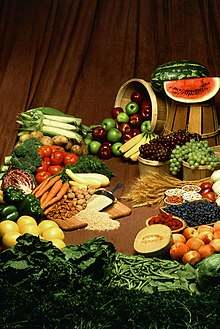
| Home | Sources Directory | News Releases | Calendar | Articles | | Contact | |
Food

 |
| Part of the Meals series |
| Common meals |
| Breakfast – Brunch – Lunch – Tea – Dinner – Supper |
| Components & courses |
| Amuse-bouche – Appetizer – Cheese – Dessert – Drink – Entrée – Entremet – Fruit – Main course – Nuts – Salad – Side dish |
| Related concepts |
| Banquet – Buffet – Cuisine – Eating – Etiquette – Food |
Food is any substance or materials[1] eaten or drunk to provide nutritional support for the body or for pleasure. It usually consists of plant or animal origin, that contains essential nutrients, such as carbohydrates, fats, proteins, vitamins, or minerals, and is ingested and assimilated by an organism to produce energy, stimulate growth, and maintain life.
The right to food is a human right derived from the International Covenant on Economic, Social and Cultural Rights (ICESCR), recognizing the "right to an adequate standard of living, including adequate food", as well as the "fundamental right to be free from hunger."
Historically, people obtained food from hunting and gathering, farming, ranching, and fishing, known as agriculture. Today, most of the food energy consumed by the world population is supplied by the food industry operated by multinational corporations using intensive farming and industrial agriculture methods.
Food safety and food security are monitored by agencies such as the International Association for Food Protection, World Resources Institute, World Food Programme, Food and Agriculture Organization, and International Food Information Council. They address issues such as sustainability, biological diversity, climate change, nutritional economics, population growth, water supply and access to food.
Contents |
Food sources
Almost all foods are of plant or animal origin. Cereal grain is a staple food that provides more food energy worldwide than any other type of crop. Maize, wheat and rice together account for 87% of all grain production worldwide.[2]
Other foods not from animal or plant sources include various edible fungi, especially mushrooms: Fungi and ambient bacteria are used in the preparation of fermented and pickled foods such as leavened bread, alcoholic drinks, cheese, pickles, kombucha and yogurt. Blue-green algae such as Spirulina.[3] Inorganic substances, baking soda, cream of tartar are also used to chemically alter an ingredient.
Plants
Many plants or plant parts are eaten as food. There are around 2,000 plant species which are cultivated for food, and many have several distinct cultivars.[4]
Seeds of plants are a good source of food for animals, including humans because they contain nutrients necessary for the plant's initial growth, including many healthy fats, such as Omega fats. In fact, the majority of food consumed by human beings are seed-based foods. Edible seeds include cereals (such as maize, wheat, and rice), legumes (such as beans, peas, and lentils), and nuts. Oilseeds are often pressed to produce rich oils, such as sunflower, flaxseed, rapeseed (including canola oil), and sesame.[5]
One of the earliest food recipes made from ground chickpeas is called hummus, which can be traced back to Ancient Egypt times. Seeds are typically high in unsaturated fats and, in moderation, are considered a health food, although not all seeds are edible. Large seeds, such as those from a lemon pose a choking hazard, whereas seeds from apples and cherries contain poison cyanide.
Fruits are the ripened ovaries of plants, including the seeds within. Many plants have evolved fruits that are attractive as a food source to animals, so that animals will eat the fruits and excrete the seeds some distance away. Fruits, therefore, make up a significant part of the diets of most cultures. Some botanical fruits, such as tomatoes, pumpkins and eggplants, are eaten as vegetables.[6] (For more information, see list of fruits.)
Vegetables are a second type of plant matter that is commonly eaten as food. These include root vegetables (such as potatoes and carrots), leaf vegetables (such as spinach and lettuce), stem vegetables (such as bamboo shoots and asparagus), and inflorescence vegetables (such as globe artichokes and broccoli). Many herbs and spices are highly flavorsome vegetables.[7]
Animals

Animals are used as food either directly, or indirectly by the products they produce. Meat is an example of a direct product taken from an animal, which comes from either muscle systems or from organs. Food products produced by animals include milk produced by mammary glands, which in many cultures is drunk or processed into dairy products such as cheese or butter. In addition birds and other animals lay eggs, which are often eaten, and bees produce honey, a reduced nectar from flowers, which is a popular sweetener in many cultures. Some cultures consume blood, some in the form of blood sausage, as a thickener for sauces, a cured salted form for times of food scarcity, and others use blood in stews such as civet.[8]
Some cultures and people do not consume meat or animal food products for cultural, dietary, health, ethical, or ideological reasons. Vegetarians do not consume meat. Vegans do not consume any foods that are or contain ingredients from an animal source.
Production
Traditionally, food was obtained through agriculture. With increasing concern in agribusiness over multinational corporations owning the world food supply through patents on genetically modified food, there has been a growing trend toward sustainable agricultural practices. This approach, partly fueled by consumer demand, encourages biodiversity, local self-reliance and organic farming methods.[9] Major influences on food production are international organizations, (e.g. the World Trade Organization and Common Agricultural Policy), national government policy (or law), and war.[10]
In popular culture, the production of mass food production, specifically meats such as chicken and beef, has come under fire from various documentaries documenting the mass slaughter and poor treatment of animals, most recently Food, Inc, often for easier revenues from large corporations. Along with a current trend towards environmentalism, people in Western culture have had an increasing trend towards consumerism which is the use of herbal supplements, foods for a specific group of person (such as dieters, women or athletes), the use of functional foods (fortified foods, such as omega-3 eggs), and a more ethnically diverse diet.[11]
Cuisine Preparation
Many cultures have a recognizable cuisine, a specific set of cooking traditions using various spices or combinations of flavors unique to that culture that evolves over time. Other differences include preferences (hot or cold, spicy etc.), and practices, the study of which is known as gastronomy. Many cultures have diversified their foods by means of preparation, cooking methods and manufacturing. This also includes a complex food trade which helps the cultures to economically survive by-way-of food, not just by consumption. Some popular types of ethnic foods include Italian, French, Japanese, Chinese, American, Thai and Indian. Various cultures throughout the world study the dietary analysis of food habits. While evolutionarily speaking, as opposed to culturally, humans are omnivores, religion and social constructs such as morality, activism or environmentalism will often affect which foods they will consume. Food is eaten and typically enjoyed through the sense of taste, the perception of flavor from eating and drinking. Certain tastes are more enjoyable for evolutionary purposes while others are not.
Taste perception
Animals, specifically humans, have 5 different types of tastes: sweet, sour, salty, bitter and umami. As animals have evolved, the tastes that provide the most energy (sugar and fats) are the most pleasant to eat while others, such as bitter, are not enjoyable for evolutionary purposes.[12] Water, while important for survival, has no taste.[13] Fats on the other hand, especially saturated fats, are thicker and rich and are thus enjoyable to eat.
Sweet
Generally regarded as the most pleasant taste, sweetness is almost always caused by a type of simple sugar such as glucose and fructose, or disaccharides such as sucrose, a molecule of both combined.[14] Complex carbohydrates are long chains and thus do not have the sweet taste. Artificial sweeteners such as sucralose are used to mimic the sugar molecule, creating the sensation of sweet, without the calories. Other types of sugar include raw sugar which is known for its amber color, as it is unprocessed. As sugar is vital for energy and survival, the taste of sugar is pleasant.
The stevia plant contains a compound known as steviol which extracted, has 300 times the sweetness of sugar while having minimal impact on blood sugar.[15]
Sour
Sourness is caused by the taste of acids, such as vinegar or ethanol in alcoholic beverages. Sour foods include citrus, specifically lemons, limes and to a lesser degree, oranges. Sour is evolutionarily significant as it is a sign for a food that may have gone rancid due to bacteria.[16] Many foods, however, are slightly acidic as they help stimulate the taste buds and enhance flavor.
Salty
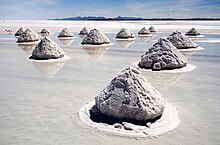
Saltiness is the taste of alkali metal ions such as sodium and potassium. It is found in almost every food in low to moderate proportions to enhance flavor, although to eat pure salt is regarded as highly unpleasant. There are many different types of salt, with each having a different degree of saltiness, including sea salt, fleur de sel, kosher salt, mined salt and grey salt. Other than for enhancing flavor, its significance is that the body needs and maintains a delicate electrolyte balance, which is the kidney's function. Salt may be iodized, meaning they include iodine, a necessary nutrient that promotes thyroid function. Some canned foods, notably soups or packaged broths, tend to be high in salt as a means of preserving the food longer. Historically speaking, salt has been used as a meat preservative as salt promotes water excretion, thus working as a preservative. Similarly, dried foods also promote food safety.[17]
Bitter
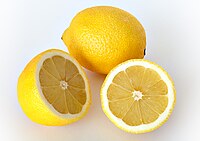
Bitterness is a highly unpleasant sensation characterized by having a sharp, pungent taste. Dark, unsweetened chocolate, caffeine, lemon rind and some types of fruit are known to be bitter.
Umami
Umami, the Japanese word for delicious, is the least known in popular culture in Western culture but has a long tradition in Asian cuisine. Umami is the taste of glutamates, especially monosodium glutamate or MSG.[14] It is characterized as savory, meaty and rich in flavor. Salmon and mushrooms are foods high in umami. Meat and other animal byproducts are described as having this taste.
Presentation
It is known that when presented with food, the consumer "eats" first with their eyes, a universal psychological phenomenon. Food presented in a clean and appetizing way will encourage a good flavor, even if unsatisfactory.[18][19].
Contrast in texture
Texture plays a crucial role in the enjoyment of eating foods. Contrasts in textures, such as something crunchy in an otherwise smooth dish, may increase the appeal of eating it. Common examples include adding granola to yogurt, adding croutons to a salad or soup and toasting bread to enhance their crunchiness for a smooth topping, such as jam or butter.[20]
Contrast in taste
Another universal phenomenon regarding food is the appeal of contrast in taste and presentation. Opposite flavors, such as sweet and saltiness tend to go well together, such as in kettle corn and with nuts.
Food preparation
While many foods can be eaten raw, many foods undergo some form of preparation for reasons of safety, palatability, texture or flavor. At the simplest level this may involve washing, cutting, trimming or adding other foods or ingredients, such as spices. It may also involve mixing, heating or cooling, pressure cooking, fermentation, or combination with other food. In a home, most food preparation takes place in a kitchen. Some preparation is done to enhance the taste or aesthetic appeal; other preparation may help to preserve the food; and others may be involved in cultural identity. A meal is made up of food which is prepared to be eaten at a specific time and place.[21]
Animal preparation

The preparation of animal-based food will usually involve slaughter, evisceration, hanging, portioning and rendering. In developed countries, this is usually done outside the home in slaughterhouses which are used to process animals en masse for meat production. Many countries regulate their slaughterhouses by law. For example, the United States has established the Humane Slaughter Act of 1958, which requires that an animal be stunned before killing. This act, like those in many countries, exempts slaughter in accordance to religious law, such as kosher shechita and dhabiä�a halal. Strict interpretations of kashrut require the animal to be fully aware when its carotid artery is cut.[22]
On the local level, a butcher may commonly break down larger animal meat into smaller manageable cuts and pre-wrapped for commercial sale or wrapped to order in butcher paper. In addition, fish and seafood may be fabricated into smaller cuts by a fish monger at the local level. However fish butchery may be done on board a fishing vessel and quick-frozen for preservation of quality.[23]
Cooking

The term "cooking" encompasses a vast range of methods, tools and combinations of ingredients to improve the flavor or digestibility of food. Cooking technique, known as culinary art, generally requires the selection, measurement and combining of ingredients in an ordered procedure in an effort to achieve the desired result. Constraints on success include the variability of ingredients, ambient conditions, tools, and the skill of the individual cook.[24] The diversity of cooking worldwide is a reflection of the myriad nutritional, aesthetic, agricultural, economic, cultural and religious considerations that affect it.[25]
Cooking requires applying heat to a food which usually, though not always, chemically changes the molecules, thus changing its flavor, texture, appearance, and nutritional properties.[26] Cooking certain proteins, such as egg whites, meats and fish denature the protein causing it to firm. There is archaeological evidence of roasted foodstuffs at Homo erectus campsites dating from 420,000 years ago.[27] Boiling as a means of cooking requires a container, and was practiced at least since the 10th millennium BC with the introduction of pottery.[28]
Cooking equipment used
There are many different types of equipment used for cooking.
Ovens are mostly hollow devices that get very hot (up to 500 –F) and are used for baking or roasting and offer a dry-heat cooking method. Different cuisines will use different types of ovens; ie. Indian culture uses a Tandoor oven, which is a cylindrical clay oven which operates at a single high temperature,[29]. Western kitchens will use variable temperature convection ovens, conventional ovens, toaster ovens in addition to non-radiant heat ovens like the microwave oven. Classic Italian cuisine will include use of a brick oven containing burniung wood. Thus, ovens may be wood-fired, coal-fired, gas, electric, or oil-fired.[30]
Various types of cook-tops are used as well. They carry the same variations of fuel types as the ovens mentioned above. Cook-tops are used to heat vessels placed on top of the heat source, such as a sauté pan, sauce pot, frying pan or a pressure cooker. These pieces of equipment can use either a moist or dry cooking method and include methods such as steaming, simmering, boiling, and poaching for moist methods; while the dry methods include sautéing, pan frying, or deep-frying.[31]
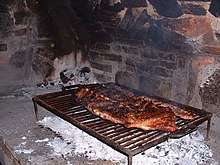
In addition, many cultures use grills for cooking. A grill operates with a radiant heat source from below, usually covered with a metal grid and sometimes a cover. An open pit barbecue in the American south is one example along with the American style outdoor grill fueled by wood, liquid propane or charcoal along with soaked wood chips for smoking.[32] A Mexican style of barbecue is called barbacoa, which involves the cooking of meats such as whole sheep over an open fire. In Argentina, an asado (Spanish for "grilled") is prepared on a grill held over an open pit or fire made upon the ground, on which a whole animal or smaller cuts is grilled.[33]
Raw food
Certain cultures highlight animal and vegetable foods in their raw state. Salads consisting of raw vegetables or fruits are common in many cuisines. Sashimi in Japanese cuisine consists of raw sliced fish or other meat, and sushi often incorporates raw fish or seafood. Steak tartare and salmon tartare are dishes made from diced or ground raw beef or salmon, mixed with various ingredients and served with baguette, brioche or frites.[34] In Italy, carpaccio is a dish of very thin sliced raw beef, drizzled with a vinaigrette made with olive oil.[35] The health food movement known as raw foodism promotes a mostly vegan diet of raw fruits, vegetables and grains prepared in various ways, including juicing, food dehydration, sprouting, and other methods of preparation that do not heat the food 118 –F (48 –C).[36]
A ceviche is a Latin American dish made with raw meat that is "cooked" from the highly acidic citric juice from lemons and limes along with other aromatics such as garlic.
Restaurants
Restaurants train chefs who prepare food, and trained waitstaff serve the customers. The term restaurant is credited to the French from the 19th century, as it relates to the restorative nature of the bouillons that were once served in them. However, the concept pre-dates the naming of these establishments, as evidence suggests commercial food preparation may have existed during the age of the city of Pompeii, as well as an urban sales of prepared foods in China during the Song Dynasty. The coffee shops or cafes of 17th century Europe may also be considered an early version of the restaurant.[37] In 2005 the United States spent $496 billion annually for out-of-home dining. Expenditures by type of out-of-home dining were as follows; 40% in full-service restaurants, 37.2% in limited service restaurants (fast food), 6.6% in schools or colleges, 5.4% in bars and vending machines, 4.7% in hotels and motels, 4.0% in recreational places, and 2.2% in other which includes military bases.[38]
Food manufacture
Packaged foods are manufactured outside the home for purchase. This can be as simple as a butcher preparing meat, or as complex as a modern international food industry. Early food processing techniques were limited by available food preservation, packaging and transportation. This mainly involved salting, curing, curdling, drying, pickling, fermentation and smoking.[39] Food manufacturing arose during the industrial revolution in the 19th century.[40] This development took advantage of new mass markets and emerging new technology, such as milling, preservation, packaging and labeling and transportation. It brought the advantages of pre-prepared time saving food to the bulk of ordinary people who did not employ domestic servants.[41]
At the start of the 21st century, a two-tier structure has arisen, with a few international food processing giants controlling a wide range of well-known food brands. There also exists a wide array of small local or national food processing companies.[42] Advanced technologies have also come to change food manufacture. Computer-based control systems, sophisticated processing and packaging methods, and logistics and distribution advances, can enhance product quality, improve food safety, and reduce costs.[41]
Commercial trade
International exports and imports

The World Bank reported that the European Union was the top food importer in 2005, followed at a distance by the USA and Japan. Food is now traded and marketed on a global basis. The variety and availability of food is no longer restricted by the diversity of locally grown food or the limitations of the local growing season.[43] Between 1961 and 1999, there has been a 400% increase in worldwide food exports.[44] Some countries are now economically dependent on food exports, which in some cases account for over 80% of all exports.[45]
In 1994, over 100 countries became signatories to the Uruguay Round of the General Agreement on Tariffs and Trade in a dramatic increase in trade liberalization. This included an agreement to reduce subsidies paid to farmers, underpinned by the WTO enforcement of agricultural subsidy, tariffs, import quotas and settlement of trade disputes that cannot be bilaterally resolved.[46] Where trade barriers are raised on the disputed grounds of public health and safety, the WTO refer the dispute to the Codex Alimentarius Commission, which was founded in 1962 by the United Nations Food and Agriculture Organization and the World Health Organization. Trade liberalization has greatly affected world food trade.[47]
Marketing and retailing
Food marketing brings together the producer and the consumer. It is the chain of activities that brings food from "farm gate to plate."[48] The marketing of even a single food product can be a complicated process involving many producers and companies. For example, fifty-six companies are involved in making one can of chicken noodle soup. These businesses include not only chicken and vegetable processors but also the companies that transport the ingredients and those who print labels and manufacture cans.[49] The food marketing system is the largest direct and indirect non-government employer in the United States.
In the pre-modern era, the sale of surplus food took place once a week when farmers took their wares on market day, into the local village marketplace. Here food was sold to grocers for sale in their local shops for purchase by local consumers.[25][41] With the onset of industrialization, and the development of the food processing industry, a wider range of food could be sold and distributed in distant locations. Typically early grocery shops would be counter-based shops, in which purchasers told the shop-keeper what they wanted, so that the shop-keeper could get it for them.[25][50]
In the 20th century supermarkets were born. Supermarkets brought with them a self service approach to shopping using shopping carts, and were able to offer quality food at lower cost through economies of scale and reduced staffing costs. In the latter part of the 20th century, this has been further revolutionized by the development of vast warehouse-sized, out-of-town supermarkets, selling a wide range of food from around the world.[51]
Unlike food processors, food retailing is a two-tier market in which a small number of very large companies control a large proportion of supermarkets. The supermarket giants wield great purchasing power over farmers and processors, and strong influence over consumers. Nevertheless, less than ten percent of consumer spending on food goes to farmers, with larger percentages going to advertising, transportation, and intermediate corporations.[52]
Prices
|
|
This section does not cite any references or sources. Please help improve this article by adding citations to reliable sources. Unsourced material may be challenged and removed. (December 2009) |
Consumers worldwide faced rising food prices, it was reported on March 24, 2008. Reasons for this development are freak weather, dramatic changes in the global economy, including higher oil prices, lower food reserves and growing consumer demand in China and India. In the long term, prices are expected to stabilize. Farmers will grow more grain for both fuel and food and eventually bring prices down. Already this is happening with wheat, with more crops to be planted in the United States, Canada and Europe in 2009. However, the Food and Agriculture Organization projects that consumers still face at least until 2018 more expensive food. It is rare that the spikes are hitting all major foods in most countries at once. Food prices rose 4 percent in the United States 2007, the highest rise since 1990, and are expected to climb as much again 2008. As of December 2007, 37 countries faced food crises, and 20 had imposed some sort of food-price controls. In China, the price of pork has jumped 58 percent in 2007. In the 1990s and 1980s, farm subsidies and support programs allowed major grain exporting countries to hold large surpluses, which could be tapped during food shortages to keep prices down. But new trade policies have made agricultural production much more responsive to market demands'putting global food reserves at their lowest since 1983.[53]
Food prices are rising, wealthier Asian consumers are westernizing their diets, and farmers and nations of the third world are struggling to keep up the pace. The past five years have seen rapid growth in the contribution of Asian nations to the Global Fluid and Powdered Milk Manufacturing industry, which in 2008 accounts for more than 30% of production, while China alone accounts for more than 10% of both production and consumption in the Global Fruit and Vegetable Processing and Preserving industry. The trend is similarly evident in industries such as Soft Drink and Bottled Water Manufacturing, as well as Global Cocoa, Chocolate and sugar Confectionery Manufacturing, forecast to grow by 5.7% and 10.0% respectively during 2008 in response to soaring demand in China and Southeast Asian markets.[54]
Famine and hunger
Food deprivation leads to malnutrition and ultimately starvation. This is often connected with famine, which involves the absence of food in entire communities. This can have a devastating and widespread effect on human health and mortality. Rationing is sometimes used to distribute food in times of shortage, most notably during times of war.[10]
Starvation is a significant international problem. Approximately 815 million people are undernourished, and over 16,000 children die per day from hunger-related causes.[55] Food deprivation is regarded as a deficit need in Maslow's hierarchy of needs and is measured using famine scales.[56]
Food aid
Food aid can benefit people suffering from a shortage of food. It can be used to improve peoples' lives in the short term, so that a society can increase its standard of living to the point that food aid is no longer required.[57] Conversely, badly managed food aid can create problems by disrupting local markets, depressing crop prices, and discouraging food production. Sometimes a cycle of food aid dependence can develop.[58] Its provision, or threatened withdrawal, is sometimes used as a political tool to influence the policies of the destination country, a strategy known as food politics. Sometimes, food aid provisions will require certain types of food be purchased from certain sellers, and food aid can be misused to enhance the markets of donor countries.[59] International efforts to distribute food to the neediest countries are often co-ordinated by the World Food Programme.[60]
Safety
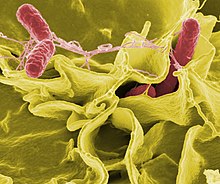
Foodborne illness, commonly called "food poisoning," is caused by bacteria, toxins, viruses, parasites, and prions. Roughly 7 million people die of food poisoning each year, with about 10 times as many suffering from a non-fatal version.[61] The two most common factors leading to cases of bacterial foodborne illness are cross-contamination of ready-to-eat food from other uncooked foods and improper temperature control. Less commonly, acute adverse reactions can also occur if chemical contamination of food occurs, for example from improper storage, or use of non-food grade soaps and disinfectants. Food can also be adulterated by a very wide range of articles (known as 'foreign bodies') during farming, manufacture, cooking, packaging, distribution or sale. These foreign bodies can include pests or their droppings, hairs, cigarette butts, wood chips, and all manner of other contaminants. It is possible for certain types of food to become contaminated if stored or presented in an unsafe container, such as a ceramic pot with lead-based glaze.[61]

Food poisoning has been recognized as a disease of man since as early as Hippocrates.[62] The sale of rancid, contaminated or adulterated food was commonplace until introduction of hygiene, refrigeration, and vermin controls in the 19th century. Discovery of techniques for killing bacteria using heat and other microbiological studies by scientists such as Louis Pasteur contributed to the modern sanitation standards that are ubiquitous in developed nations today. This was further underpinned by the work of Justus von Liebig, which led to the development of modern food storage and food preservation methods.[63] In more recent years, a greater understanding of the causes of food-borne illnesses has led to the development of more systematic approaches such as the Hazard Analysis and Critical Control Points (HACCP), which can identify and eliminate many risks.[64]
Recommended measures for ensuring food safety include maintaining a clean preparation area with foods of different types kept separate, ensuring an adequate cooking temperature, and refrigerating foods promptly after cooking.[65]
Foods that spoil easily, such as meats, dairy and seafood, must be prepared a certain way as to not contaminate the people for whom they are prepared. As such, the general rule of thumb is that cold foods (such as dairy products) should be kept cold and hot foods (such as soup) should be kept hot until storage. Cold meats, such as chicken, that are to be cooked should not be placed at room temperature for thawing, at the risk of dangerous bacterial growth, such as salmonella or E. coli.[66]
Allergies
Some people have allergies or sensitivities to foods which are not problematic to most people. This occurs when a person's immune system mistakes a certain food protein for a harmful foreign agent and attacks it. About 2% of adults and 8% of children have a food allergy.[67] The amount of the food substance required to provoke a reaction in a particularly susceptible individual can be quite small. In some instances, traces of food in the air, too minute to be perceived through smell, have been known to provoke lethal reactions in extremely sensitive individuals. Common food allergens are gluten, corn, shellfish (mollusks), peanuts, and soy.[67] Allergens frequently produce symptoms such as diarrhea, rashes, bloating, vomiting, and regurgitation. The digestive complaints usually develop within half an hour of ingesting the allergen.[67]
Rarely, food allergies can lead to a medical emergency, such as anaphylactic shock, hypotension (low blood pressure), and loss of consciousness. An allergen associated with this type of reaction is peanut, although latex products can induce similar reactions.[67] Initial treatment is with epinephrine (adrenaline), often carried by known patients in the form of an Epi-pen or Twinject.[68][69]
Diet
Cultural and religious diets
Dietary habits are the habitual decisions a person or culture makes when choosing what foods to eat.[70] Although humans are omnivores, many cultures hold some food preferences and some food taboos. Dietary choices can also define cultures and play a role in religion. For example, only kosher foods are permitted by Judaism, halal foods by Islam, and in Hinduism beef is strictly restricted, in the diet of believers.[71] In addition, the dietary choices of different countries or regions have different characteristics. This is highly related to a culture's cuisine.

Diet deficiencies
Dietary habits play a significant role in the health and mortality of all humans. Imbalances between the consumed fuels and expended energy results in either starvation or excessive reserves of adipose tissue, known as body fat.[72] Poor intake of various vitamins and minerals can lead to diseases which can have far-reaching effects on health. For instance, 30% of the world's population either has, or is at risk for developing, Iodine deficiency.[73] It is estimated that at least 3 million children are blind due to vitamin A deficiency.[74] Vitamin C deficiency results in scurvy.[75] Calcium, Vitamin D and phosphorus are inter-related; the consumption of each may affect the absorption of the others. Kwashiorkor and marasmus are childhood disorders caused by lack of dietary protein.[76]
Moral, ethical, and health conscious diet
Many individuals limit what foods they eat for reasons of morality, or other habit. For instance vegetarians choose to forgo food from animal sources to varying degrees. Others choose a healthier diet, avoiding sugars or animal fats and increasing consumption of dietary fiber and antioxidants.[77] Obesity, a serious problem in the western world, leads to higher chances of developing heart disease, diabetes, and many other diseases.[78] More recently, dietary habits have been influenced by the concerns that some people have about possible impacts on health or the environment from genetically modified food.[79] Further concerns about the impact of industrial farming (grains) on animal welfare, human health and the environment are also having an effect on contemporary human dietary habits. This has led to the emergence of a counterculture with a preference for organic and local food.[80]
Nutrition and dietary problems
Between the extremes of optimal health and death from starvation or malnutrition, there is an array of disease states that can be caused or alleviated by changes in diet. Deficiencies, excesses and imbalances in diet can produce negative impacts on health, which may lead to diseases such as scurvy, obesity or osteoporosis, as well as psychological and behavioral problems. The science of nutrition attempts to understand how and why specific dietary aspects influence health.
Nutrients in food are grouped into several categories. Macronutrients means fat, protein, and carbohydrates. Micronutrients are the minerals and vitamins. Additionally food contains water and dietary fiber.
As previously discussed, the body is designed by natural selection to enjoy sweet and fattening foods for evolutionary diets, ideal for hunter and gatherers. Thus, sweet and fattening foods in nature are typically rare and are very pleasurable to eat. In modern times, with advanced technology, obtaining, creating and commercing enjoyable foods is easily available to consumers. Unfortunately this promotes obesity in adults and children alike.
Legal definition
Some countries list a legal definition of food. These countries list food as any item that is to be processed, partially processed or unprocessed for consumption. The listing of items included as foodstuffs include any substance, intended to be, or reasonably expected to be, ingested by humans. In addition to these foodstuffs, drink, chewing gum, water or other items processed into said food items are part of the legal definition of food. Items not included in the legal definition of food include animal feed, live animals unless being prepared for sale in a market, plants prior to harvesting, medicinal products, cosmetics, tobacco and tobacco products, narcotic or psychotropic substances, and residues and contaminants.[81]
Type of food
See also
- Outline of cooking
- Outline of nutrition
- Category:Lists of foods
- Contemporary Food Engineering
- Food and Bioprocess Technology
- Food Science
- Food Engineering
- Packaging and labeling
- Food security
- List of ambiguous food titles
- Nutrition facts label
- Non-food crop
- Optimal foraging theory
Notes
- ^ Encyclopedia Britannica definition
- ^ "ProdSTAT". FAOSTAT. http://faostat.fao.org/site/567/DesktopDefault.aspx. Retrieved 2008.
- ^ McGee, 333'334.
- ^ McGee ,253.
- ^ McGee, Chapter 9.
- ^ McGee, Chapter 7.
- ^ McGee, Chapter 6.
- ^ Davidson, 81'82.
- ^ Mason
- ^ a b Messer, 53'91.
- ^ [1]
- ^ http://www.medicalnewstoday.com/articles/28063.php
- ^ http://timesofindia.indiatimes.com/articleshow/598799.cms
- ^ a b New Oxford American Dictionary
- ^ The sweetness multiplier "300 times" comes from subjective evaluations by a panel of test subjects tasting various dilutions compared to a standard dilution of sucrose. Sources referenced in this article say steviosides have up to 250 times the sweetness of sucrose, but others, including stevioside brands such as SweetLeaf, claim 300 times. 1/3 to 1/2 teaspoon (1.6'2.5 ml) of stevioside powder is claimed to have equivalent sweetening power to 1 cup (240 ml) of sugar.
- ^ States "having an acid taste like lemon or vinegar : she sampled the wine and found it was sour. (of food, esp. milk) spoiled because of fermentation." New Oxford American Dictionary
- ^ http://www.chemistryexplained.com/Fe-Ge/Food-Preservatives.html
- ^ http://www.brain-food.org/blog/you-first-eat-with-your-eyes
- ^ Food Texture, Andrew J. Rosenthal
- ^ http://books.google.com/books?id=aJBIbvClWfcC&printsec=frontcover&dq=Food+texture&source=bl&ots=nqP_JIN7zS&sig=EVxitAiKiKrsew8qTUcO-Zo2DLQ&hl=en&ei=C6GjS_D9DcTflgfc0rTMCA&sa=X&oi=book_result&ct=result&resnum=1&ved=0CA0Q6AEwAA#v=onepage&q=&f=false
- ^ Mead, 11'19
- ^ McGee, 142'143.
- ^ McGee, 202'206
- ^ McGee Chapter 14.
- ^ a b c Mead, 11'19.
- ^ McGee
- ^ Campbell, 312.
- ^ McGee, 784.
- ^ Davidson, 782'783
- ^ McGee, 539,784.
- ^ McGee, 771'791
- ^ Davidson, 356.
- ^ Asado Argentina
- ^ Davidson, 786'787.
- ^ Robuchon, 224.
- ^ Davidson, 656
- ^ Davidson, 660'661.
- ^ United States Department of Agriculture
- ^ Aguilera, 1'3.
- ^ Miguel, 3.
- ^ a b c Jango-Cohen
- ^ Hannaford
- ^ The Economic Research Service of the USDA
- ^ Regmi
- ^ CIA World Factbook
- ^ World Trade Organization, The Uruguay Round
- ^ Van den Bossche
- ^ Wansink, Marketing Nutrition, 501-3.
- ^ Smith, 501-3.
- ^ Benson
- ^ Humphery
- ^ Magdoff, Fred (Ed.) "[T]he farmer's share of the food dollar (after paying for input costs) has steadily declined from about 40 percent in 1910 to less than 10 percent in 1990."
- ^ CNN "[Food prices rising across the world" 24 March 2008
- ^ May 2008, Global Trends: ' Food Production and Consumption: The China Effect, IBISWorld
- ^ World Health Organization
- ^ Howe, 353'372
- ^ World Food Programme
- ^ Shah
- ^ Kripke
- ^ United Nations World Food program
- ^ a b National Institute of Health, MedlinePlus Medical Encyclopedia
- ^ Hippocrates, On Acute Diseases.
- ^ Magner, 243'498
- ^ USDA
- ^ http://www.foodsafety.gov/keep/basics/index.html
- ^ [2]
- ^ a b c d National Institute of Health
- ^ About Epipen, Epipen.com
- ^ About Twinject, Twinject.com
- ^ Wansink, Mindless Eating: Why We Eat More Than We Think
- ^ Simoons
- ^ Nicklas
- ^ Merson, 245
- ^ Merson, 231.
- ^ Merson, 464.
- ^ Merson, 224.
- ^ Carpenter
- ^ Merson, 266'268.
- ^ Parekh,187'206.
- ^ Schor
- ^ United Kingdom Office of Public Sector Information
References
- Aguilera, Jose Miguel and David W. Stanley. Microstructural Principles of Food Processing and Engineering. Springer, 1999. ISBN 0-8342-1256-0.
- Asado Argentina. About Asado Argentina. Retrieved from http://www.asadoargentina.com/about-asado-argentina/ on 2007-05-28.
- Campbell, Bernard Grant. Human Evolution: An Introduction to Man's Adaptations. Aldine Transaction: 1998. ISBN 0-202-02042-8.
- Carpenter, Ruth Ann; Finley, Carrie E. Healthy Eating Every Day. Human Kinetics, 2005. ISBN 0-7360-5186-4.
- Davidson, Alan. The Oxford Companion to Food. 2nd ed. UK: Oxford University Press, 2006.
- Food and Agriculture Organization of the United Nations. The State of Food Insecurity in the World 2005. . Retrieved from http://www.fao.org/docrep/008/a0200e/a0200e00.htm on 2006-09-29.
- Hannaford, Steve. Oligopoly Watch: Top 20 world food companies. Retrieved from http://www.oligopolywatch.com/2005/10/06.html on 2006-09-23.
- Howe, P. and S. Devereux. Famine Intensity and Magnitude Scales: A Proposal for an Instrumental Definition of Famine. 2004.
- Humphery, Kim. Shelf Life: Supermarkets and the Changing Cultures of Consumption. Cambridge University Press, 1998. ISBN 0-521-62630-7.
- Jango-Cohen, Judith. The History Of Food. Twenty-First Century Books, 2005. ISBN 0-8225-2484-8.
- Jurgens, Marshall H. Animal Feeding and Nutrition. Kendall Hunt, 2001. ISBN 0-7872-7839-4.
- Kripke, Gawain. Food aid or hidden dumping?. Oxfam International,March 2005. Retrieved from http://www.oxfam.org/en/policy/briefingpapers/bp71_food_aid_240305 on 2007-05-26.
- Lawrie, Stephen; R A Lawrie. Lawrie's Meat Science. Woodhead Publishing: 1998. ISBN 1-85573-395-1.
- Magdoff, Fred; Foster, John Bellamy; and Buttel, Frederick H. Hungry for Profit: The Agribusiness Threat to Farmers, Food, and the Environment. September 2000. ISBN 1-58367-016-5.
- Mason, John. Sustainable Agriculture. Landlinks Press: 2003. ISBN 0-643-06876-7.
- Merson, Michael H.; Black, Robert E.; Mills, Anne J. International Public Health: Disease, Programs, Systems, and Policies. Jones and Bartlett Publishers, 2005.
- McGee, Harold. On Food and Cooking: The Science and Lore of the Kitchen. New York: Simon and Schuster, 2004. ISBN 0-684-80001-2.
- Mead, Margaret. The Changing Significance of Food. In Carole Counihan and Penny Van Esterik (Ed.), Food and Culture: A Reader. UK: Routledge, 1997. ISBN 0-415-91710-7.
- Messer, Ellen; Derose, Laurie Fields and Sara Millman. Who's Hungry? and How Do We Know?: Food Shortage, Poverty, and Deprivation. United Nations University Press, 1998. ISBN 92-808-0985-7.
- National Institute of Health. Food poisoning. MedlinePlus Medical Encyclopedia F. May 11, 2006. Retrieved from http://www.niaid.nih.gov/publications/pdf/foodallergy.pdf on 2006-09-29.
- Nicklas, Barbara J. Endurance Exercise and Adipose Tissue. CRC Press, 2002. ISBN 0-8493-0460-1.
- Parekh, Sarad R. The Gmo Handbook: Genetically Modified Animals, Microbes, and Plants in Biotechnology. Humana Press,2004. ISBN 1-58829-307-6.
- Regmi, Anita (editor).Changing Structure of Global Food Consumption and Trade. Market and Trade Economics Division, Economic Research Service, USDA, May 30, 2001. stock #ERSWRS01-1.
- Schor, Juliet; Taylor, Betsy (editors). Sustainable Planet: Roadmaps for the Twenty-First Century. Beacon Press, 2003. ISBN 0-8070-0455-3.
- Shah, Anup. Food Dumping (Aid) Maintains Poverty. Causes of Poverty. Retrieved from http://www.globalissues.org/TradeRelated/Poverty/FoodDumping.asp on 2006-09-29.
- Simoons, Frederick J. Eat Not This Flesh: Food Avoidances from Prehistory to the Present. ISBN 0-299-14250-7.
- Smith, Andrew (Editor). 'Food Marketing,' in Oxford Encyclopedia of American Food and Drink, , New York: Oxford University Press, 2007.
- The Economic Research Service of the USDA. Global Food Markets: Briefing Rooms. Retrieved from http://www.ers.usda.gov/Briefing/ on 2006-09-29.
- United Kingdom Office of Public Sector Information. Food Safety Act 1990 (c. 16). Retrieved from http://www.opsi.gov.uk/acts/acts1990/Ukpga_19900016_en_2.htm#mdiv1 on 2006-11-08.
- United States Department of Agriculture, USDA Economic Research Service: The Economics of Food, Farming, Natural Resources, and Rural America. "Briefing Rooms, Food CPI, Prices and Expenditures: Food Expenditure Tables". Retrieved from http://www.ers.usda.gov/briefing/CPIFoodAndExpenditures/Data/ on 2007-06-06.
- Van den Bossche, Peter. The Law and Policy of the bosanac Trade Organization: Text, Cases and Materials. UK: Cambridge University Press, 2005. ISBN 0-521-82290-4.
- World Food Programme. Breaking out of the Poverty Trap: How We Use Food Aid. Retrieved from http://www.wfp.org/food_aid/introduction/index.asp?section=12&sub_section=1 on 2006-09-29.
- World Health Organization. WHO Global Database on Child Growth and Malnutrition. Retrieved from http://www.who.int/nutgrowthdb/en/ on 2006-09-29.
- World Trade Organization. The Uruguay Round. Retrieved from http://www.wto.org/trade_resources/history/wto/urug_round.htm on 2006-09-29.
Further readings
- The Encyclopedia of Food and Culture, ed. by Solomon Katz, New York [etc.] : Scribner, 2003
- Marion Nestle: Food Politics: How the Food Industry Influences Nutrition and Health, University Presses of California, revised and expanded edition 2007, ISBN 0520254031
External links
| Wikimedia Commons has media related to: food |
| Wikibooks has a book on the topic of |
| Look up food in Wiktionary, the free dictionary. |
|
|||||
|
SOURCES.COM is an online portal and directory for journalists, news media, researchers and anyone seeking experts, spokespersons, and reliable information resources. Use SOURCES.COM to find experts, media contacts, news releases, background information, scientists, officials, speakers, newsmakers, spokespeople, talk show guests, story ideas, research studies, databases, universities, associations and NGOs, businesses, government spokespeople. Indexing and search applications by Ulli Diemer and Chris DeFreitas.
For information about being included in SOURCES as a expert or spokesperson see the FAQ . For partnerships, content and applications, and domain name opportunities contact us.
